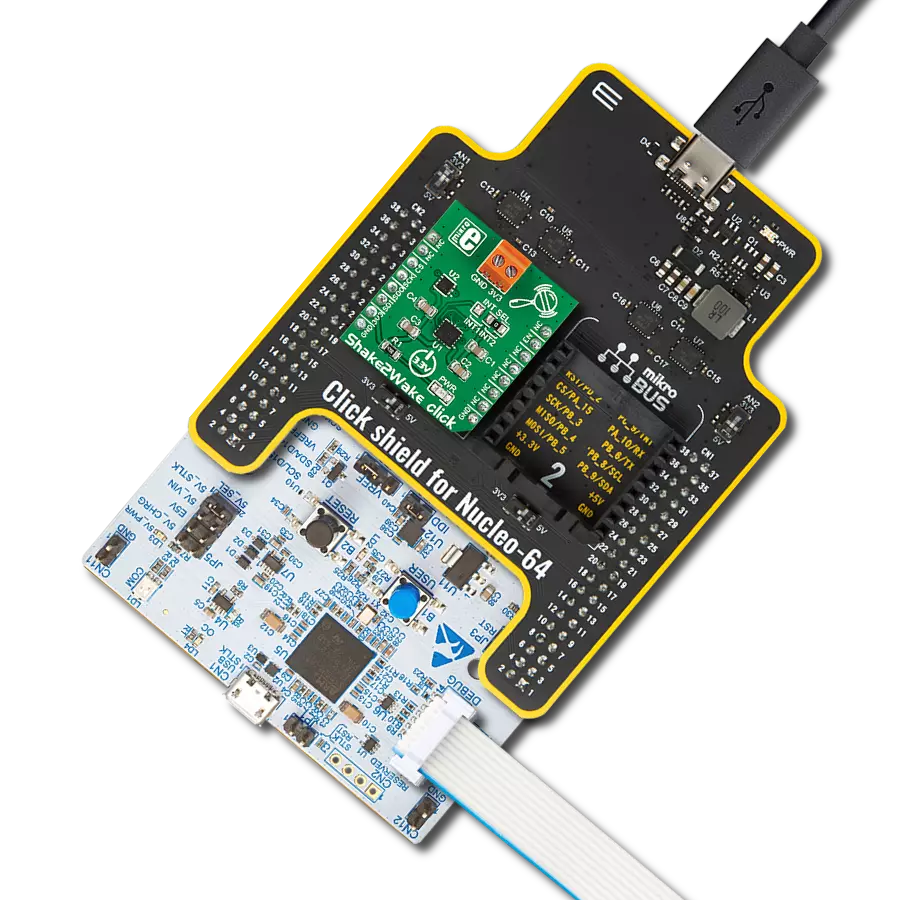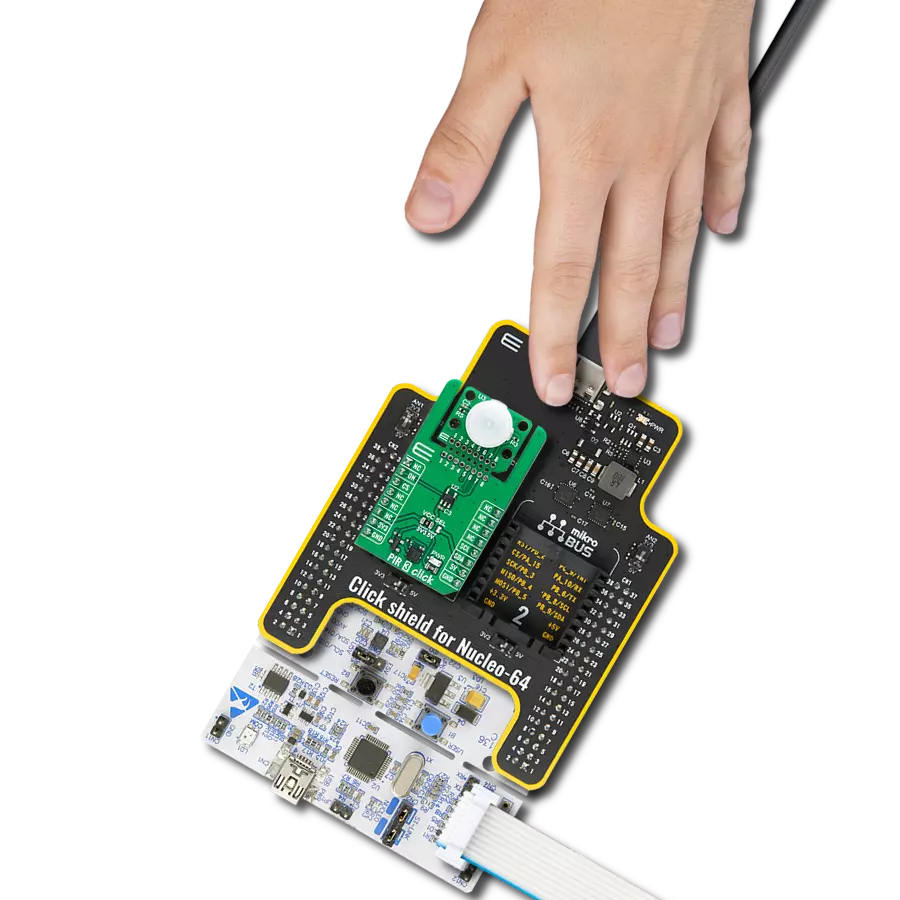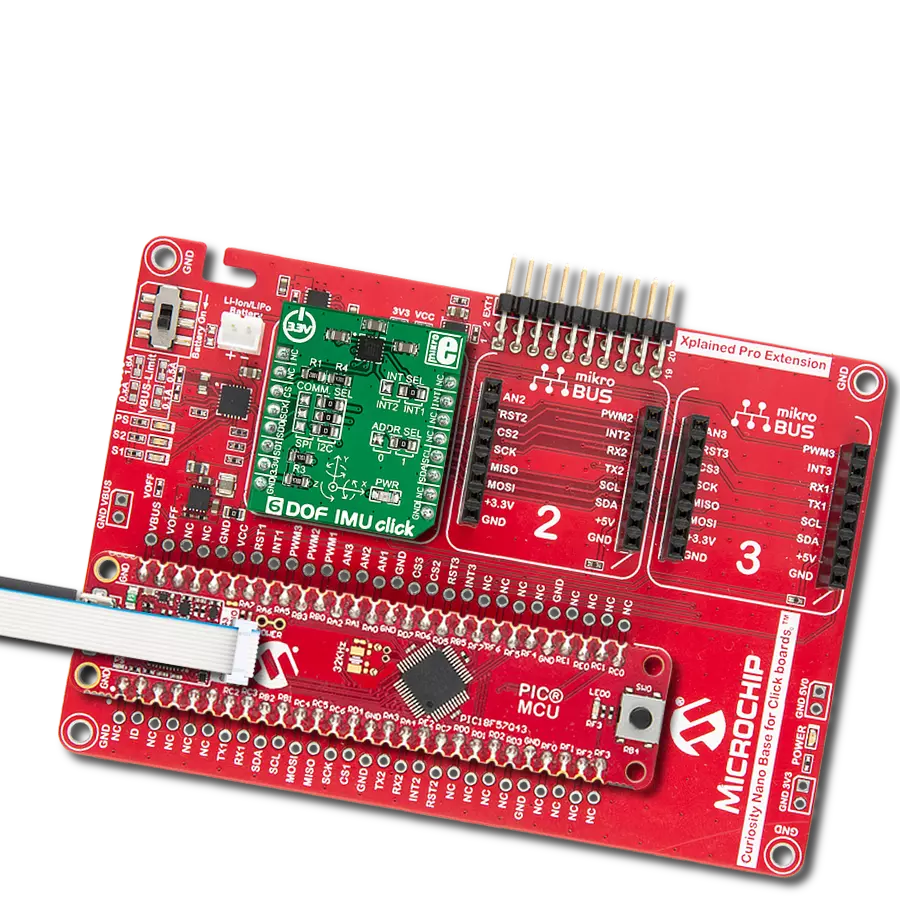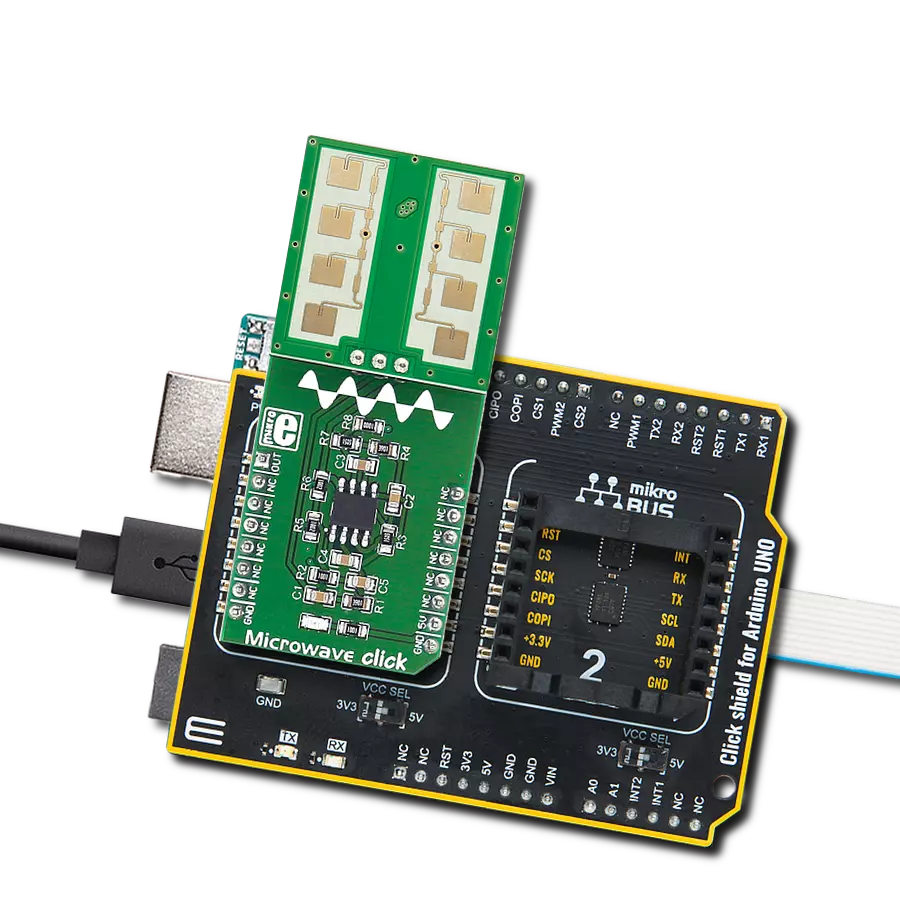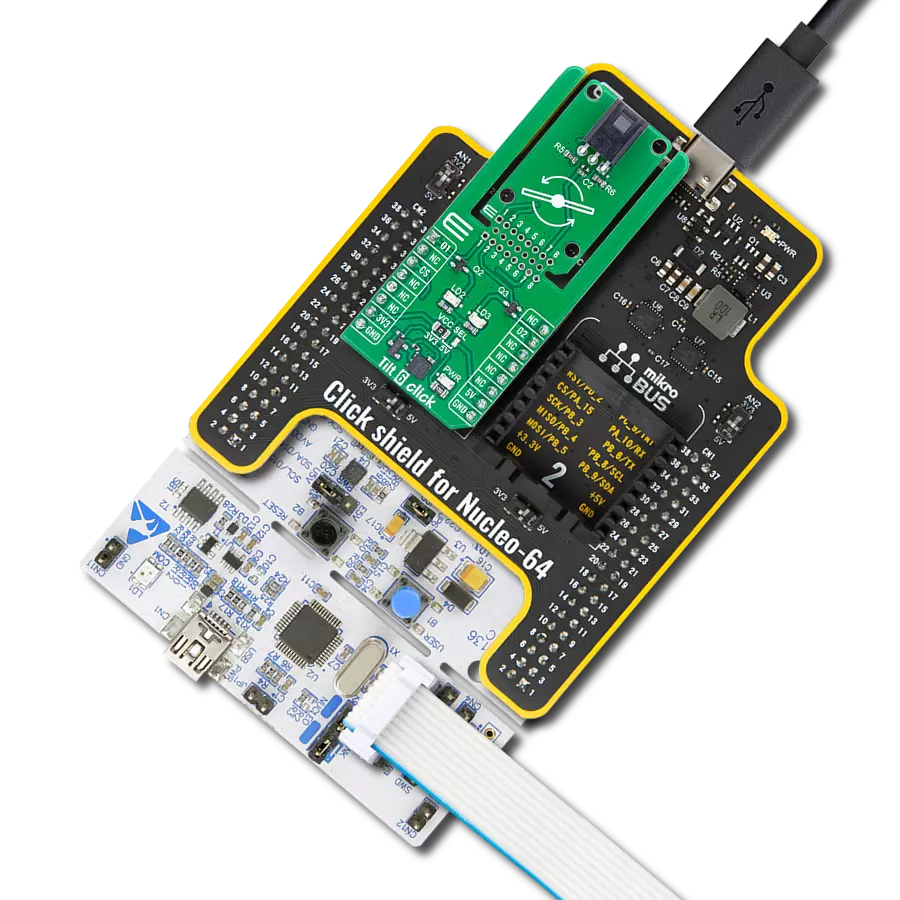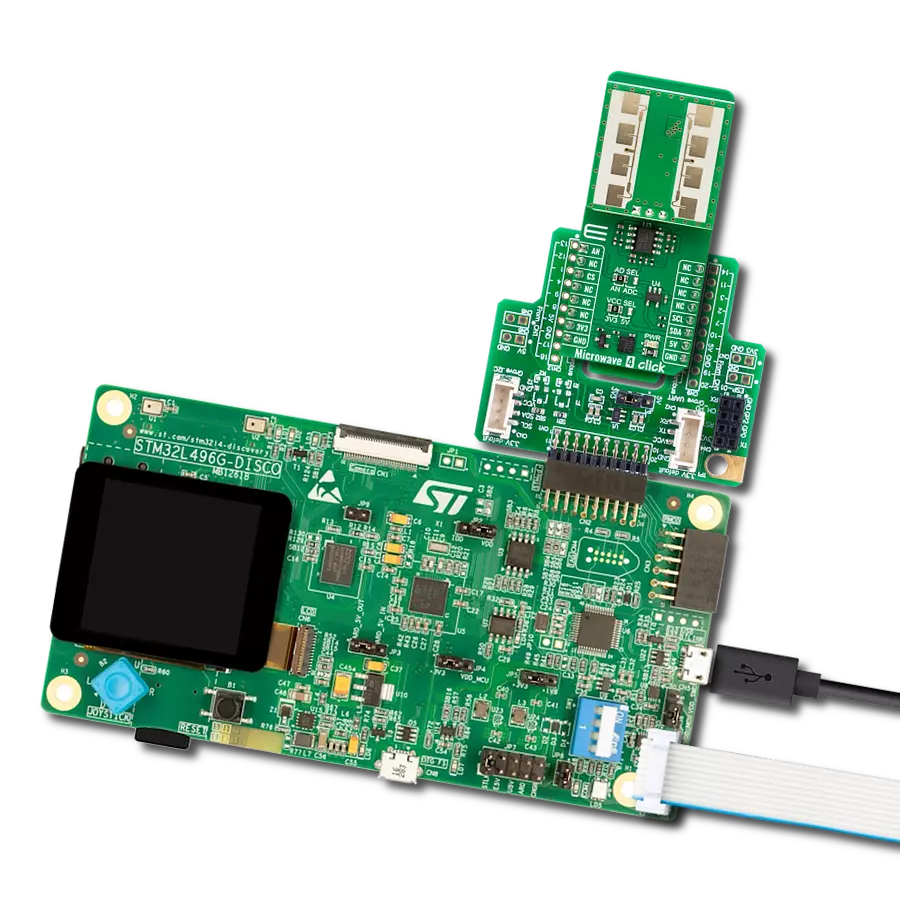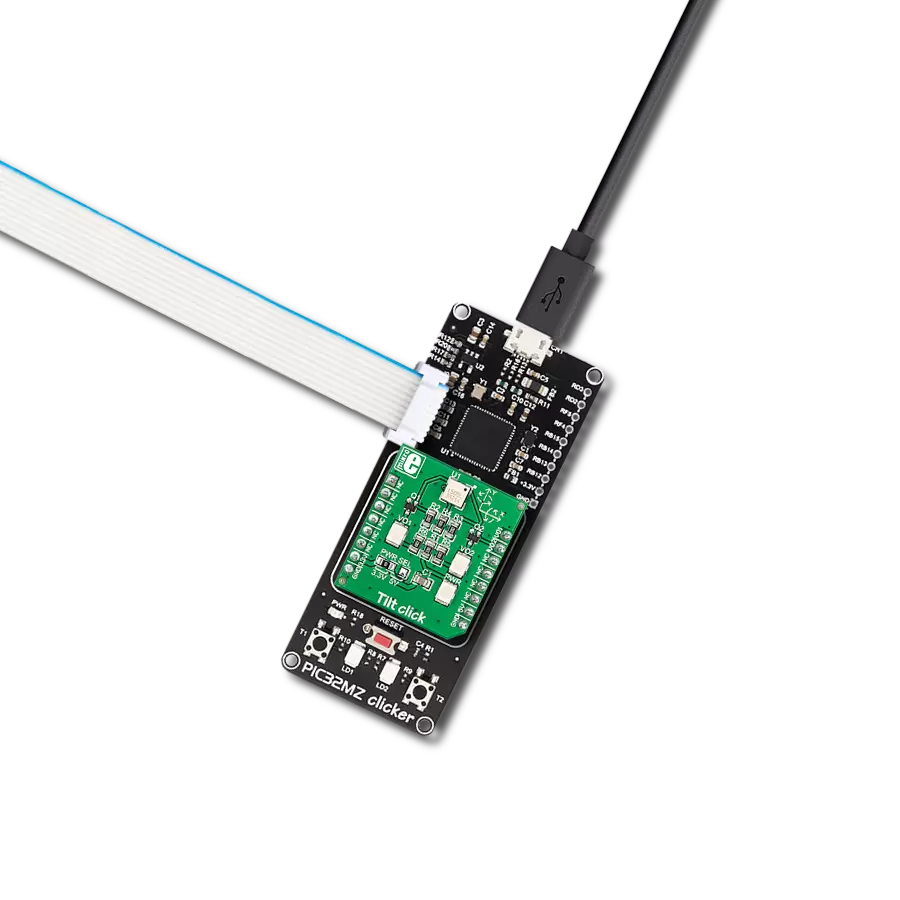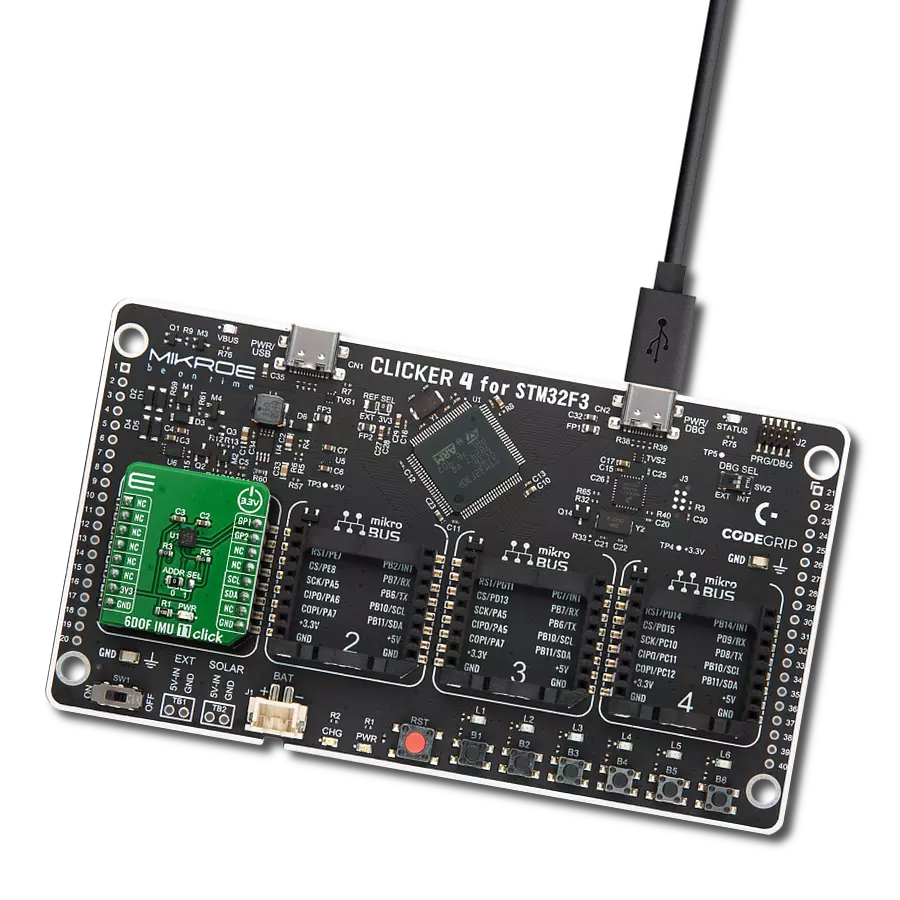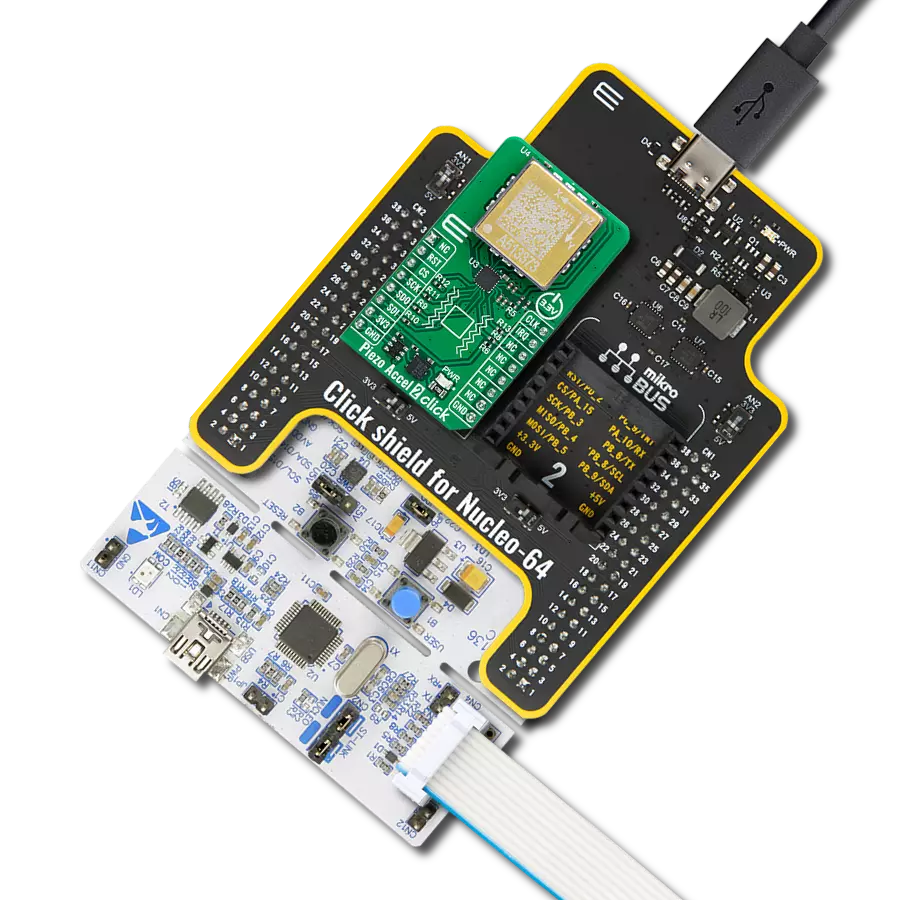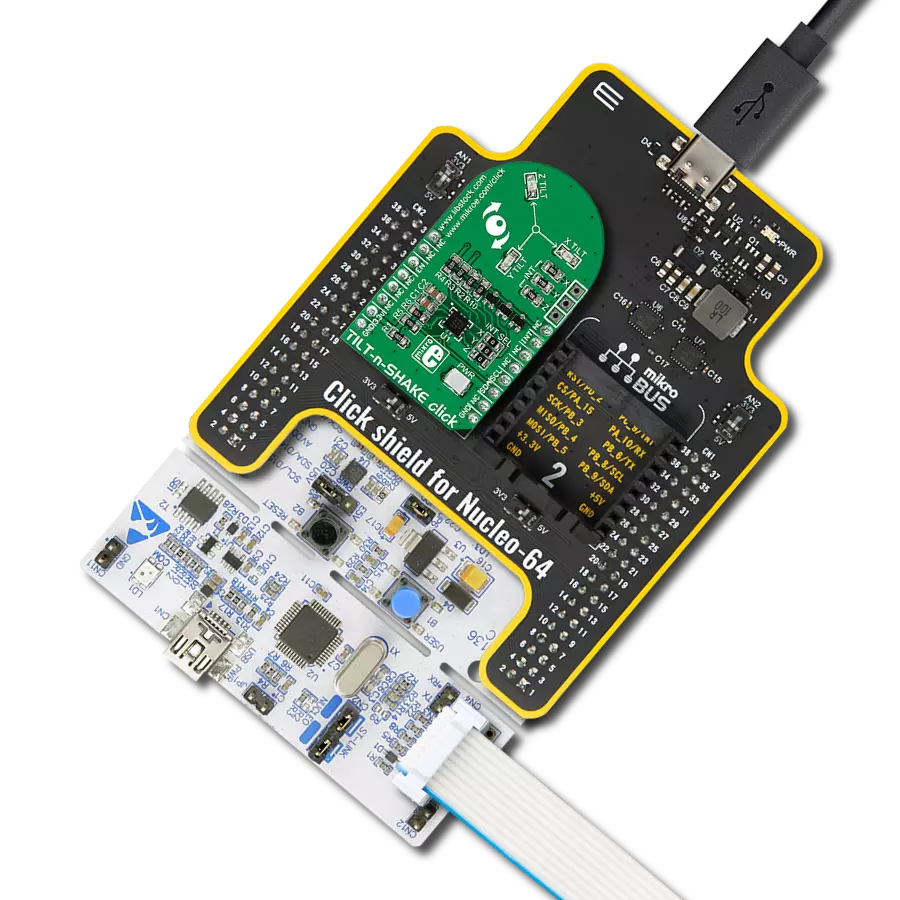High-speed motion tracking with real-time inertial measurement perfect for drones, robotics, and IoT
A
A
Hardware Overview
How does it work?
6DOF IMU 24 Click is based on the ICM-40609-D sensor from TDK InvenSense, specifically designed for high-performance applications in the drone market. This 6-axis MEMS MotionTracking™ device integrates a 3-axis gyroscope and a 3-axis accelerometer, offering exceptional precision and reliability even under demanding conditions. Its sophisticated architecture significantly enhances overall IMU performance, maintaining accuracy across a wide temperature range. This makes it particularly well-suited for drones and flight controllers, robotics, and IoT solutions, ensuring stability and precise control throughout extended flight durations, even when exposed to fluctuating temperatures. A key advantage of the ICM-40609-D is its integrated 2KB FIFO buffer, which optimizes data processing by reducing serial interface traffic. This not only minimizes power consumption but also allows the system processor to operate in low-power mode while periodically retrieving burst data. The gyroscope offers eight programmable full-scale range settings, ranging from ±15.625dps to ±2000dps, providing flexibility for different motion
tracking requirements. Additionally, the accelerometer supports four full-scale ranges, spanning from ±4g to an extended ±32g, enabling precise detection of both subtle and high-impact movements. With an impressive maximum Output Data Rate (ODR) of 32kHz, this sensor delivers the highest sampling rate available in consumer-grade devices. Such a high ODR ensures that any anomalies or inconsistencies in movement can be detected and analyzed efficiently, making it a powerful tool for flight control and navigation systems. Further emphasizing its precision, the ICM-40609-D features a gyro noise level of just 4.5mdps/√Hz, a gyro offset stability temperature coefficient of ±10mdps/°C, and an exceptionally low gyro sensitivity error of ±0.5%. The accelerometer is equally precise, with an accel noise level of 100μg/√Hz, an offset stability temperature coefficient of ±0.15mg/°C, and an accel sensitivity error of just ±0.5%. Motion data are accessed through the I2C or SPI interface, with a maximum frequency of 1MHz for I2C and 24MHz for SPI communication. The selection is made by
positioning SMD jumpers labeled COMM SEL appropriately. Note that all the jumpers' positions must be on the same side, or the Click board™ may become unresponsive. While the I2C interface is selected, the ICM-40609-D allows the least significant bit (LSB) of its I2C address to be chosen using the SMD jumper labeled ADDR SEL. This board also possesses two interrupts, INT and IT2 entirely programmed by the user through a serial interface. These interrupt signals provide notifications about key system events, such as the clock generator locking to a new reference oscillator when switching clock sources, the availability of new data to be read from the FIFO and data registers, accelerometer event interrupts, the FIFO reaching a predefined watermark level, and FIFO overflow. This Click board™ can be operated only with a 3.3V logic voltage level. The board must perform appropriate logic voltage level conversion before using MCUs with different logic levels. It also comes equipped with a library containing functions and example code that can be used as a reference for further development.
Features overview
Development board
Clicker 2 for Kinetis is a compact starter development board that brings the flexibility of add-on Click boards™ to your favorite microcontroller, making it a perfect starter kit for implementing your ideas. It comes with an onboard 32-bit ARM Cortex-M4F microcontroller, the MK64FN1M0VDC12 from NXP Semiconductors, two mikroBUS™ sockets for Click board™ connectivity, a USB connector, LED indicators, buttons, a JTAG programmer connector, and two 26-pin headers for interfacing with external electronics. Its compact design with clear and easily recognizable silkscreen markings allows you to build gadgets with unique functionalities and
features quickly. Each part of the Clicker 2 for Kinetis development kit contains the components necessary for the most efficient operation of the same board. In addition to the possibility of choosing the Clicker 2 for Kinetis programming method, using a USB HID mikroBootloader or an external mikroProg connector for Kinetis programmer, the Clicker 2 board also includes a clean and regulated power supply module for the development kit. It provides two ways of board-powering; through the USB Micro-B cable, where onboard voltage regulators provide the appropriate voltage levels to each component on the board, or
using a Li-Polymer battery via an onboard battery connector. All communication methods that mikroBUS™ itself supports are on this board, including the well-established mikroBUS™ socket, reset button, and several user-configurable buttons and LED indicators. Clicker 2 for Kinetis is an integral part of the Mikroe ecosystem, allowing you to create a new application in minutes. Natively supported by Mikroe software tools, it covers many aspects of prototyping thanks to a considerable number of different Click boards™ (over a thousand boards), the number of which is growing every day.
Microcontroller Overview
MCU Card / MCU
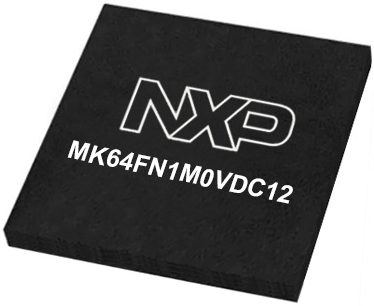
Architecture
ARM Cortex-M4
MCU Memory (KB)
1024
Silicon Vendor
NXP
Pin count
121
RAM (Bytes)
262144
Used MCU Pins
mikroBUS™ mapper
Take a closer look
Click board™ Schematic

Step by step
Project assembly
Track your results in real time
Application Output
1. Application Output - In Debug mode, the 'Application Output' window enables real-time data monitoring, offering direct insight into execution results. Ensure proper data display by configuring the environment correctly using the provided tutorial.

2. UART Terminal - Use the UART Terminal to monitor data transmission via a USB to UART converter, allowing direct communication between the Click board™ and your development system. Configure the baud rate and other serial settings according to your project's requirements to ensure proper functionality. For step-by-step setup instructions, refer to the provided tutorial.
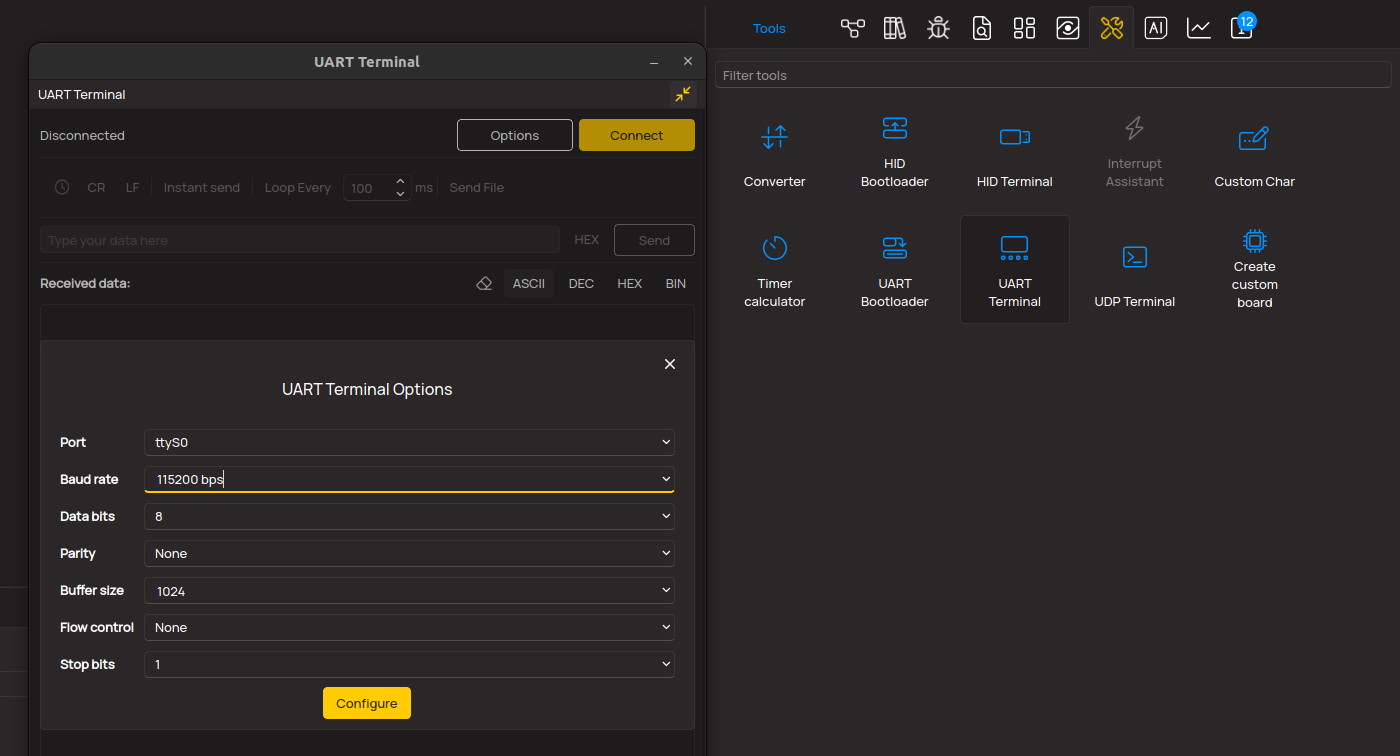
3. Plot Output - The Plot feature offers a powerful way to visualize real-time sensor data, enabling trend analysis, debugging, and comparison of multiple data points. To set it up correctly, follow the provided tutorial, which includes a step-by-step example of using the Plot feature to display Click board™ readings. To use the Plot feature in your code, use the function: plot(*insert_graph_name*, variable_name);. This is a general format, and it is up to the user to replace 'insert_graph_name' with the actual graph name and 'variable_name' with the parameter to be displayed.
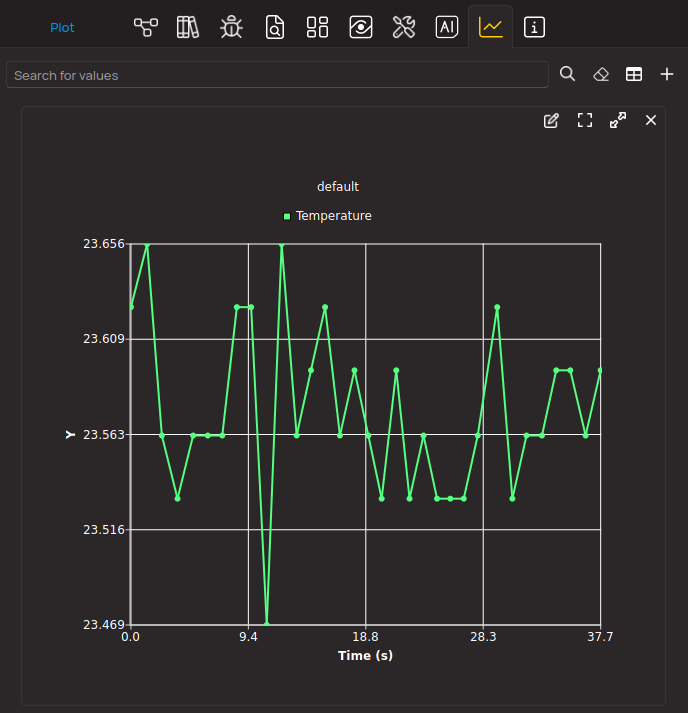
Software Support
Library Description
6DOF IMU 24 Click demo application is developed using the NECTO Studio, ensuring compatibility with mikroSDK's open-source libraries and tools. Designed for plug-and-play implementation and testing, the demo is fully compatible with all development, starter, and mikromedia boards featuring a mikroBUS™ socket.
Example Description
This example demonstrates the use of 6DOF IMU 24 Click by reading and displaying the accelerometer and gyroscope data (X, Y, and Z axis) as well as a temperature measurement in degrees Celsius.
Key functions:
c6dofimu24_cfg_setup- Config Object Initialization function.c6dofimu24_init- Initialization function.c6dofimu24_default_cfg- Click Default Configuration function.c6dofimu24_get_int1_pin- This function returns the INT1 pin logic state.c6dofimu24_clear_data_ready- This function clears the data ready interrupt by reading the INT_STATUS register.c6dofimu24_read_data- This function reads the accelerometer, gyroscope, and temperature measurement data.
Application Init
Initializes the driver and performs the Click default configuration.
Application Task
Waits for a data ready indication and then reads the accelerometer, gyroscope, and temperature measurements. The results are displayed on the USB UART every 80ms as per the accel and gyro output data rate which is set to 12.5Hz.
Open Source
Code example
The complete application code and a ready-to-use project are available through the NECTO Studio Package Manager for direct installation in the NECTO Studio. The application code can also be found on the MIKROE GitHub account.
/*!
* @file main.c
* @brief 6DOF IMU 24 Click example
*
* # Description
* This example demonstrates the use of 6DOF IMU 24 Click board by reading and displaying
* the accelerometer and gyroscope data (X, Y, and Z axis) as well as a temperature measurement
* in degrees Celsius.
*
* The demo application is composed of two sections :
*
* ## Application Init
* Initializes the driver and performs the Click default configuration.
*
* ## Application Task
* Waits for a data ready indication and then reads the accelerometer, gyroscope, and temperature
* measurements. The results are displayed on the USB UART every 80ms as per the accel and gyro
* output data rate which is set to 12.5 Hz.
*
* @author Stefan Filipovic
*
*/
#include "board.h"
#include "log.h"
#include "c6dofimu24.h"
static c6dofimu24_t c6dofimu24;
static log_t logger;
void application_init ( void )
{
log_cfg_t log_cfg; /**< Logger config object. */
c6dofimu24_cfg_t c6dofimu24_cfg; /**< Click config object. */
/**
* Logger initialization.
* Default baud rate: 115200
* Default log level: LOG_LEVEL_DEBUG
* @note If USB_UART_RX and USB_UART_TX
* are defined as HAL_PIN_NC, you will
* need to define them manually for log to work.
* See @b LOG_MAP_USB_UART macro definition for detailed explanation.
*/
LOG_MAP_USB_UART( log_cfg );
log_init( &logger, &log_cfg );
log_info( &logger, " Application Init " );
// Click initialization.
c6dofimu24_cfg_setup( &c6dofimu24_cfg );
C6DOFIMU24_MAP_MIKROBUS( c6dofimu24_cfg, MIKROBUS_1 );
err_t init_flag = c6dofimu24_init( &c6dofimu24, &c6dofimu24_cfg );
if ( ( I2C_MASTER_ERROR == init_flag ) || ( SPI_MASTER_ERROR == init_flag ) )
{
log_error( &logger, " Communication init." );
for ( ; ; );
}
if ( C6DOFIMU24_ERROR == c6dofimu24_default_cfg ( &c6dofimu24 ) )
{
log_error( &logger, " Default configuration." );
for ( ; ; );
}
log_info( &logger, " Application Task " );
}
void application_task ( void )
{
static c6dofimu24_data_t meas_data;
if ( !c6dofimu24_get_int1_pin ( &c6dofimu24 ) )
{
c6dofimu24_clear_data_ready ( &c6dofimu24 );
if ( C6DOFIMU24_OK == c6dofimu24_read_data ( &c6dofimu24, &meas_data ) )
{
log_printf ( &logger, " Accel X: %.2f g\r\n", meas_data.accel.x );
log_printf ( &logger, " Accel Y: %.2f g\r\n", meas_data.accel.y );
log_printf ( &logger, " Accel Z: %.2f g\r\n", meas_data.accel.z );
log_printf ( &logger, " Gyro X: %.1f dps\r\n", meas_data.gyro.x );
log_printf ( &logger, " Gyro Y: %.1f dps\r\n", meas_data.gyro.y );
log_printf ( &logger, " Gyro Z: %.1f dps\r\n", meas_data.gyro.z );
log_printf ( &logger, " Temperature: %.2f C\r\n\n", meas_data.temperature );
}
}
}
int main ( void )
{
/* Do not remove this line or clock might not be set correctly. */
#ifdef PREINIT_SUPPORTED
preinit();
#endif
application_init( );
for ( ; ; )
{
application_task( );
}
return 0;
}
// ------------------------------------------------------------------------ END
Additional Support
Resources
Category:Motion


















